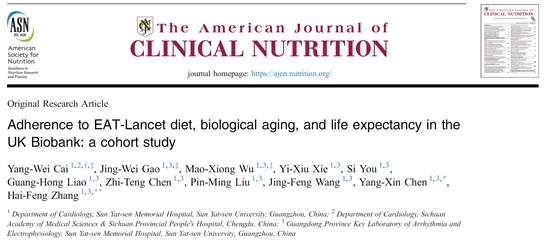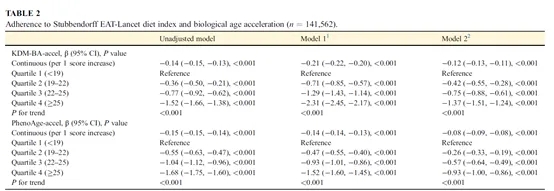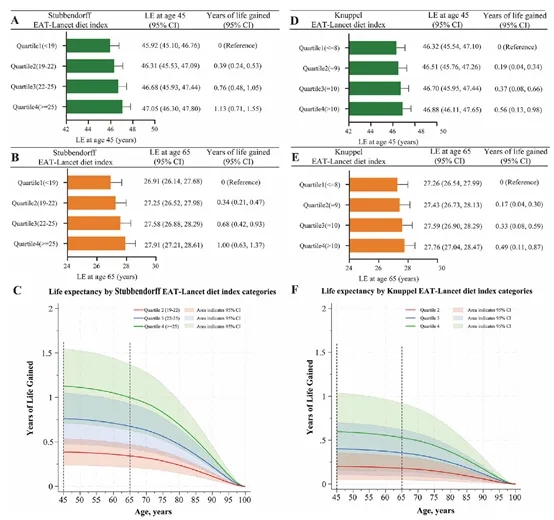[1] S. Wang, W. Li, S. Li, H. Tu, J. Jia, W. Zhao, et al., Association between plant-based dietary pattern and biological aging trajectory in a large prospective cohort, BMC Med 21 (1) (2023) 310, https://doi.org/10.1186/s12916-023-02974-9.
[2] M. Armanios, R. de Cabo, J. Mannick, L. Partridge, J. van Deursen, S. Villeda,Translational strategies in aging and age-related disease, Nat. Med. 21 (12)(2015) 1395–1399, https://doi.org/10.1038/nm.4004.
[3] X. Gao, T. Geng, M. Jiang, N. Huang, Y. Zheng, D.W. Belsky, et al.,Accelerated biological aging and risk of depression and anxiety: evidence from 424,299 UK Biobank participants, Nat. Commun. 14 (1) (2023) 2277, https://doi.org/10.1038/s41467-023-38013-7.
[4] L. Chen, B. Wu, L. Mo, H. Chen, Y. Zhao, T. Tan, et al., Associations between biological ageing and the risk of, genetic susceptibility to, and life expectancy associated with rheumatoid arthritis: a secondary analysis of two observational studies, Lancet. Healthy. Longev. 5 (1) (2024) e45–e55, https://doi.org/10.1016/S2666-7568(23)00220-9.
[5] X. Gao, Y. Wang, Z. Song, M. Jiang, T. Huang, A.A. Baccarelli, Early-life risk factors, accelerated biological aging and the late-life risk of mortality and morbidity, Q.J.M 117 (4) (2023) hcad247. https://doi.org/10.1093/qjmed/hcad247.
[6] M.E. Levine, Modeling the rate of senescence: can estimated biological age predict mortality more accurately than chronological age? J. Gerontol. - Biol.Sci. Med. Sci. 68 (6) (2013) 667–674, https://doi.org/10.1093/gerona/gls233.
[7] S. Ahadi, W. Zhou, S.M. Schüssler-Fiorenza Rose, M.R. Sailani,K. Contrepois, M. Avina, et al., Personal aging markers and ageotypes revealed by deep longitudinal profiling, Nat. Med. 26 (1) (2020) 83–90, https://doi.org/10.1038/s41591-019-0719-5.
[8] X. Wang, H. Ma, X. Li, Y. Heianza, J.E. Manson, O.H. Franco, et al.,Association of cardiovascular health with life expectancy free of cardiovascular disease, diabetes, cancer, and dementia in UK adults, JAMA. Intern. Med. 183
(4) (2023) 340, https://doi.org/10.1001/jamainternmed.2023.0015.
[9] Q. Sun, D. Yu, J. Fan, C. Yu, Y. Guo, P. Pei, et al., Healthy lifestyle and life expectancy at age 30 years in the Chinese population: an observational study,Lancet. Public. Health 7 (12) (2022) e994–e1004, https://doi.org/10.1016/S2468-2667(22)00110-4.
[10] L. Fontana, L. Partridge, Promoting health and longevity through diet: frommodel organisms to humans, Cell 161 (1) (2015) 106–118, https://doi.org/10.1016/j.cell.2015.02.020.
[11] X. Wang, S. kumar sarker, L. Cheng, K. Dang, J. Hu, S. Pan, et al., Association of dietary inflammatory potential, dietary oxidative balance score and biological aging, Clin. Nutr. 43 (1) (2024) 1–10, https://doi.org/10.1016/j.clnu.2023.11.007.
[12] Y. Liu, M. Kang, W. Wei, J. Hui, Y. Gou, C. Liu, et al., Dietary diversity score and the acceleration of biological aging: a population-based study of 88,039 participants, J. Nutr. Health Aging 28 (6) (2024) 100271, https://doi.org/10.1016/j.jnha.2024.100271.
[13] S. Esposito, A. Gialluisi, S. Costanzo, A. Di Castelnuovo, E. Ruggiero, A. De Curtis, et al., Mediterranean diet and other dietary patterns in association with biological aging in the Moli-sani Study cohort, Clin. Nutr. 41 (5) (2022) 1025–1033, https://doi.org/10.1016/j.clnu.2022.02.023.
[14] F.B. Hu, Diet strategies for promoting healthy aging and longevity: an epidemiological perspective, J. Intern. Med. 295 (4) (2024) 508–531, https://doi.org/10.1111/joim.13728.
[15] M.A. Clark, M. Springmann, J. Hill, D. Tilman, Multiple health and environmental impacts of foods, Proc. Natl. Acad. Sci. U.S.A. 116 (46) (2019) 23357–23362, https://doi.org/10.1073/pnas.1906908116.
[16] W. Willett, J. Rockstr€ om, B. Loken, M. Springmann, T. Lang, S. Vermeulen, et al., Food in the anthropocene: the EAT–Lancet commission on healthy diets from sustainable food systems, Lancet 393 (10170) (2019) 447–492, https://
doi.org/10.1016/S0140-6736(18)31788-4.
[17] C. Carcel, C. Bushnell, Can dietary patterns that support planetary health benefit population health? Stroke 53 (1) (2022) 164–166, https://doi.org/10.1161/STROKEAHA.121.037314.
[18] A. Knuppel, K. Papier, T.J. Key, R.C. Travis, EAT-Lancet score and major health outcomes: the EPIC-Oxford study, Lancet 394 (10194) (2019) 213–214, https://doi.org/10.1016/S0140-6736(19)31236-X.
[19] A. Stubbendorff, D. Stern, U. Ericson, E. Sonestedt, E. Hallstr€ om, Y. Borne, et al., A systematic evaluation of seven different scores representing the EAT–Lancet reference diet and mortality, stroke, and greenhouse gas emissions
in three cohorts, Lancet. Planet. Health. 8 (6) (2024) e391–e401, https://doi.org/10.1016/S2542-5196(24)00094-9.
[20] N. Karavasiloglou, A.S. Thompson, G. Pestoni, A. Knuppel, K. Papier,A. Cassidy, et al., Adherence to the EAT-Lancet reference diet is associated with a reduced risk of incident cancer and all-cause mortality in UK adults, One,Earth 6 (12) (2023) 1726–1734, https://doi.org/10.1016/j.oneear.2023.11.002.
[21] S. Zhang, J. Dukuzimana, A. Stubbendorff, U. Ericson, Y. Borne, E. Sonestedt, Adherence to the EAT-Lancet diet and risk of coronary events in the Malm€oDiet and cancer cohort study, Am. J. Clin. Nutr. 117 (5) (2023) 903–909,
https://doi.org/10.1016/j.ajcnut.2023.02.018.
[22] X. Lu, L. Wu, L. Shao, Y. Fan, Y. Pei, X. Lu, et al., Adherence to the EAT-Lancet diet and incident depression and anxiety, Nat. Commun. 15 (1) (2024)5599, https://doi.org/10.1038/s41467-024-49653-8.
[23] H. Wu, J. Wei, S. Wang, L. Chen, J. Zhang, N. Wang, et al., Dietary pattern modifies the risk of MASLD through metabolomic signature, JHEP. Reports 6
(8) (2024) 101133, https://doi.org/10.1016/j.jhepr.2024.101133.
[24] P. Klemera, S. Doubal, A new approach to the concept and computation of biological age, Mech. Ageing, Dev 127 (3) (2006) 240–248, https://doi.org/10.1016/j.mad.2005.10.004.
[25] Z. Liu, P.L. Kuo, S. Horvath, E. Crimmins, L. Ferrucci, M. Levine, A new aging measure captures morbidity and mortality risk across diverse subpopulations from NHANES IV: a cohort study, PLoS, Med 15 (12) (2018) e1002718, https://doi.org/10.1371/journal.pmed.1002718.
[26] D. Kwon, D.W. Belsky, A toolkit for quantification of biological age from blood chemistry and organ function test data: BioAge, GeroScience 43 (6)
(2021) 2795–2808, https://doi.org/10.1007/s11357-021-00480-5.[27] Y.V. Chudasama, K. Khunti, C.L. Gillies, et al., Healthy lifestyle and life expectancy in people with multimorbidity in the UK Biobank: a longitudinal cohort study, PLoS Med. 17 (2020) e1003332, https://doi.org/10.1371/journal.pmed.1003332.
[28] P. Mohammadi-Shemirani, M. Chong, S. Narula, N. Perrot, D. Conen,J.D. Roberts, et al., Elevated lipoprotein(a) and risk of atrial fibrillation, J. Am.Coll. Cardiol. 79 (16) (2022) 1579–1590, https://doi.org/10.1016/j.jacc.2022.02.018.
[29] F. Cui, L. Tang, D. Li, Y. Ma, J. Wang, J. Xie, et al., Early-life exposure to tobacco, genetic susceptibility, and accelerated biological aging in adulthood,Sci. Adv. 10 (18) (2024) eadl3747, https://doi.org/10.1126/sciadv.adl3747.
[30] P.C. Lambert, P. Royston, Further development of flexible parametric models for survival analysis, Stata. J. 9 (2) (2009) 265–290, https://doi.org/10.1177/1536867X0900900206.
[31] Y.V. Chudasama, K.K. Khunti, F. Zaccardi, A.V. Rowlands, T. Yates,C.L. Gillies, et al., Physical activity, multimorbidity, and life expectancy: a UK Biobank longitudinal study, BMC, Med. 17 (1) (2019) 108, https://doi.org/10.1186/s12916-019-1339-0.
[32] Y.V. Chudasama, F. Zaccardi, C.L. Gillies, N.N. Dhalwani, T. Yates,A.V. Rowlands, et al., Leisure-time physical activity and life expectancy inpeople with cardiometabolic multimorbidity and depression, J. Intern. Med. 287(1) (2020) 87–99, https://doi.org/10.1111/joim.12987.
[33] E.W. Flanagan, J. Most, J.T. Mey, L.M. Redman, Calorie restriction and aging in humans, Annu. Rev. Nutr. 40 (1) (2020) 105–133, https://doi.org/10.1146/annurev-nutr-122319-034601.
[34] Q. Sun, M.K. Townsend, O.I. Okereke, O.H. Franco, F.B. Hu, F. Grodstein,Adiposity and weight change in mid-life in relation to healthy survival after age70 in women: prospective cohort study, BMJ 339 (sep29 1) (2009)b3796–b3796. https://doi.org/10.1136/bmj.b3796.
[35] X. Xu, J. Hu, X. Pang, X. Wang, H. Xu, X. Yan, et al., Association between plant and animal protein and biological aging: findings from the UK Biobank, Eur. J. Nutr. 63 (8) (2024) 3119–3132, https://doi.org/10.1007/s00394-024-03494-9.
[36] J.C. Newman, A.J. Covarrubias, M. Zhao, X. Yu, P. Gut, C.-P. Ng, et al.,Ketogenic diet reduces midlife mortality and improves memory in aging mice,Cell. Metab 26 (3) (2017) 547–557.e8, https://doi.org/10.1016/
j.cmet.2017.08.004.
[37] M.N. Roberts, M.A. Wallace, A.A. Tomilov, Z. Zhou, G.R. Marcotte, D. Tran,
et al., A ketogenic diet extends longevity and healthspan in adult mice,Cell. Metab 26 (3) (2017) 539–546.e5, https://doi.org/10.1016/
j.cmet.2017.08.005.
[38] H. Zhang, H. Zuo, Y. Xiang, J. Cai, N. Zhang, F. Yang, et al., Associations ofvarious healthy dietary patterns with biological age acceleration and the mediating role of gut microbiota: results from the China Multi-Ethnic Cohort study, Br. J. Nutr. 132 (11) (2024) 1–13, https://doi.org/10.1017/S0007114524002733.
[39] C. Colizzi, M.C. Harbers, R.E. Vellinga, W.M.M. Verschuren, J.M.A. Boer,S. Biesbroek, et al., Adherence to the EAT-Lancet healthy reference diet inrelation to risk of cardiovascular events and environmental impact: results fromtheEPIC-NLcohort,JAHA12(8)(2023) e026318,https://doi.org/10.1161/JAHA.122.026318.
[40] D. Sun, T. Zhang, S. Su, G. Hao, T. Chen, Q.-Z. Li, et al., Body mass indexdrives changes in DNA methylation, Circ. Res. 125 (9) (2019)824–833, https://doi.org/10.1161/CIRCRESAHA.119.315397.
[41] T.L. Gruenewald, S. Cohen, K.A. Matthews, R. Tracy, T.E. Seeman,Association of socioeconomic status with inflammation markers in black and white men and women in the Coronary Artery Risk Development in Young Adults (CARDIA) study, Soc. Sci. Med. 69 (3) (2009) 451–459, https://doi.org/10.1016/j.socscimed.2009.05.018.
[42] T. Wang, A. Masedunskas, W.C. Willett, L. Fontana, Vegetarian and vegan diets: benefits and drawbacks, Eur. Heart. J. 44 (36) (2023) 3423–3439, https://doi.org/10.1093/eurheartj/ehad436.
[43] M. Leri, M. Scuto, M.L. Ontario, V. Calabrese, E.J. Calabrese, M. Bucciantini,et al., Healthy effects of plant polyphenols: molecular mechanisms, Int. J. Mol.Sci. 21 (4) (2020) 1250, https://doi.org/10.3390/ijms21041250.
[44] P. Di Giosia, C.A. Stamerra, P. Giorgini, T. Jamialahamdi, A.E. Butler,A. Sahebkar, The role of nutrition in inflammaging, Ageing Res.Rev.77(2022)101596,https://doi.org/10.1016/j.arr.2022.101596.
[45] A.A. Johnson, A. Stolzing, The role of lipid metabolism in aging, lifespan regulation, and age-related disease, Aging. Cell. 18 (6) (2019) e13048, https://doi.org/10.1111/acel.13048.
[46] D.D. Wang, Y. Li, S.E. Chiuve, M.J. Stampfer, J.E. Manson, E.B. Rimm, et al.,
Association of specific dietary fats with total and cause-specific mortality,JAMA. Intern. Med. 176 (8) (2016) 1134, https://doi.org/10.1001/jamainternmed.2016.2417.
[47] A.M. Chao, K.M. Quigley, T.A. Wadden, Dietary interventions for obesity:clinical and mechanistic findings, J. Clin. Invest. 131 (1) (2021) e140065,https://doi.org/10.1172/JCI140065.













发表留言
暂无留言
输入您的留言参与专家互动